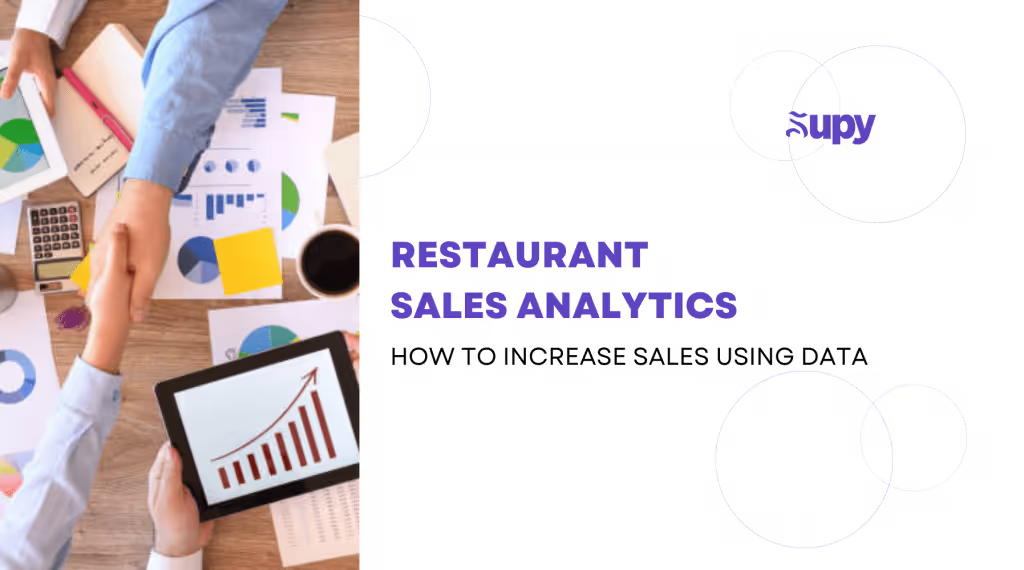Strategies for Effective Waste Management in Restaurant Chains

In today's competitive food and beverage industry, effective Waste Management in Restaurant Chains is more crucial than ever. With rising food costs and growing societal emphasis on sustainable practices, restaurant owners and managers must innovate to reduce their environmental and ecological footprint.
Today, waste management in restaurants encompasses a wide range of practices, from reducing food waste and optimizing inventory to recycling and composting. These strategies are especially important to develop in large restaurant chains, where consistent practices across multiple locations can lead to substantial cost savings.
Although implementing a robust waste management plan for your business may seem daunting at first, we promise that with the right tools and strategies in place, this is one investment you’re not likely to spend any time regretting soon.
Table of Contents
- Types of Restaurant Food Waste.
- Why is Waste Management Important for Restaurants?.
- Challenges in the Way of Establishing an Effective Waste Management Strategy.
- How to Implement an Effective Food Waste Management Strategy for Your Restaurant
- Case Studies of Successful Implementations.
- Supy's Role in Establishing Effective Waste Management in Restaurants.
- Conclusion.
- About Supy.
In this blog, we’ll be exploring strategies for effective and modern waste management systems in restaurants. We’ll learn about the different types of waste, the various advantages of developing a waste management strategy, and discover tried-and-true techniques that can help you minimize your waste while also streamlining your operations. By highlighting these strategies, we hope we can convince restaurant owners and managers alike of how easy it is to contribute towards developing a greener planet while simultaneously boosting your bottom line! It’s a win-win!
1. Types of Restaurant Food Waste
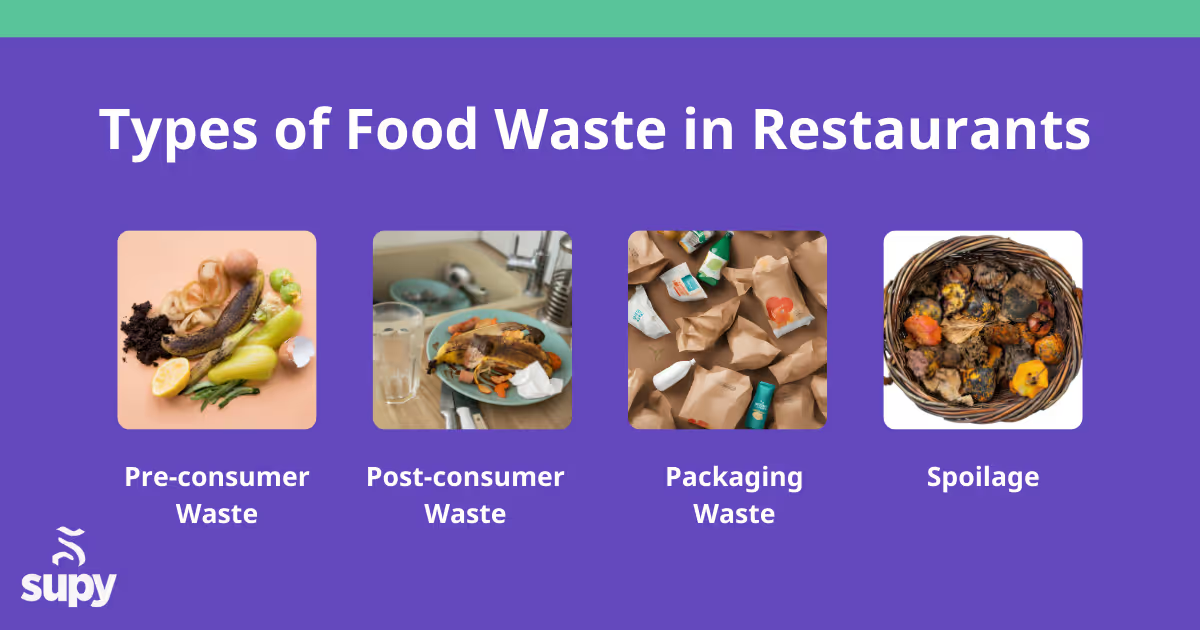
Before you can manage your waste, you need to be able to sort and identify it. Understanding the different types of food waste can help restaurant owners and managers implement the appropriate strategies to reduce waste in accordance with these needs.
Here are the four primary types of restaurant food waste:
Pre-consumer Food Waste:
This type of waste occurs during the food preparation process and is often referred to as kitchen waste. It includes peelings, trimmings, spoiled or expired ingredients, and food that is improperly prepared or overproduced.
Pre-consumer waste can be minimized through better inventory management, precise portion control, and staff training to improve preparation techniques. You could also find creative uses for these food scraps in dishes or as stocks and sauces.
Post-consumer Food Waste:
This refers to waste left by customers after their meals, including uneaten food that has been left on diner’s plates. Post-consumer waste can be reduced by optimizing portion sizes, offering customizable dishes to suit customer preferences, and encouraging diners to take leftovers home. It may also be a good idea to implement a feedback system to understand why food was left uneaten in the first place to better match customer expectations.
Packaging Waste:
Restaurants generate a substantial amount of packaging waste from ingredients, takeout containers, and single-use items like plastic utensils and straws. To reduce packaging waste, restaurants can switch to reusable or compostable materials. They can also encourage customers to bring their containers or work with suppliers to minimize packaging in and beyond their supply chain. You could also try to implement recycling programs and educate staff on proper waste segregation to further enhance your establishment’s sustainability efforts.
Spoilage:
Spoilage occurs when food goes bad before it can be used. This type of waste is often a result of poor inventory management, improper storage, or over-purchasing. By implementing an efficient inventory management system and adequate staff training on proper storage techniques, you can help minimize rates of food spoilage. Regularly rotating stock and using the first-in, first-out (FIFO) method also ensures that older items are used before they spoil.
2. Why is Waste Management Important for Restaurants?

Effective waste management in restaurants is crucial for several environmental and economic reasons:
- Managing Your Bottom Line: Did you know that trying to track food waste is a great way to cut down on restaurant costs? Cutting down on food scraps has been shown to reduce operating costs by more than 30%! By reducing wasted food, restaurants can cut down on costs associated with purchasing and disposing of excess food. For example, implementing better inventory management and portion control techniques can help you understand how much food to order to minimize over-ordering and spoilage, thereby saving money.
- Saving the Environment: Unfortunately, many modern restaurants have a very high environmental footprint. Food wastage has been shown to contribute to greenhouse gas emissions when it ends up in landfills. By adopting sustainable waste management practices, such as composting food waste and recycling, restaurants can reduce their carbon footprint and contribute to environmental conservation efforts.
- Consumer Demand for Sustainable Dining: Today’s customers are more environmentally conscious than ever. And why shouldn’t they be? According to the National Restaurant Association, 58% of millennials wont to choose a restaurant that is committed to sustainable environmental practices. By prioritizing waste management, restaurants can enhance their brand reputation and attract a broader customer base that values eco-friendly practices.
- Streamlining Your Operations: Finally, an effective waste management strategy can come in handy for restaurant owners or managers who are trying to streamline their operations across multiple locations. With a consistent waste reduction strategy, you can ensure that all your branches are operating efficiently, maintaining the same standards of sustainability.
3. Challenges in the Way of Establishing an Effective Waste Management Strategy
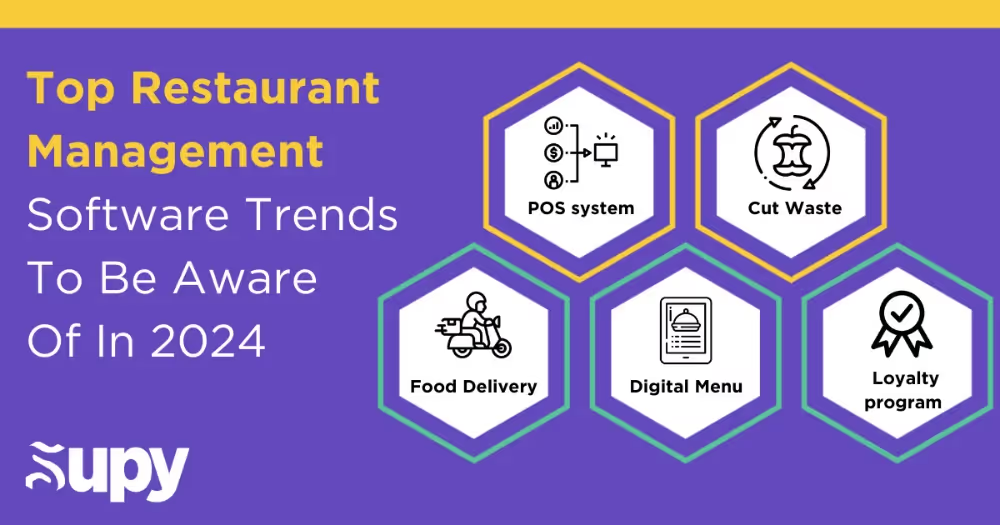
In 2024, many businesses seem to have understood the significant role technology can play in navigating the year ahead. Restaurant management software in particular seems to be leading the forefront of this revolution, providing solutions that are both efficient and easily adaptable to the complex needs of multichain operations.
Below are some of the top restaurant management software trends to be aware of in 2024:
- Restaurant POS Systems Are the New Standard
For decades, restaurant POS systems have been growing in popularity, providing businesses with a streamlined way to make orders, take payments, and streamline a range of other business processes. It’s hardly surprising then that mobile POS systems are one of the most common forms of technology used to make integrated payment processing easier and more efficient. If your business is looking to streamline its operation with cost-effective restaurant management technology, investing in Supy’s all-in-one platform is a simple no-brainer. s
- Cut Down on Waste with Restaurant Software
One way business owners are trying to shave down on costs without compromising on standards is by installing management software to track wasted stock and reduce food costs. Such software provides users with real-time reports on stock wastage levels, and as of recently is being used by up to 40% of hospitality businesses. With Supy’s restaurant inventory management software, you can cut down on your restaurant's inventory variance, reduce food costs, and eliminate food waste once and for all.
- Food Delivery Tech Is More Popular Than Ever
While consumer preferences were shifting at a gradual pace before 2020, the pandemic forced restaurants and quick-service businesses to pivot to online ordering, take-out, and delivery to remain afloat. This resulted in the rapid growth of third-party online ordering software like DoorDash, GrubHub, and Uber Eats. Here, the restaurant menu is available on a simple app on your phone for quick and easy online ordering. Despite in-person dining being available once more, however, restaurant owners may not be too happy to learn that food delivery apps remain more popular than ever, with research from Statista revealing that the apps collectively attracted 53.9 million US users in 2023 (compared to 45.6 million users in 2020).
- Digital Menu Kiosks Are Replacing Staff
Ever since the pandemic began, hospitality businesses have been struggling with employee management as service workers opted for jobs in other industries. As a result, an increasing number of quick-service and fast-casual restaurants have been turning towards installing digital kiosks for in-person or online ordering. With its user-friendly interface, this method of labor-management trend is only expected to become more popular going forward.
According to a survey by Tech. co, 36% of restaurants have purchased digital restaurant menu kiosks in the last 12 months, and a further 20% plan on purchasing the tech in the next year. This makes installing digital menu kiosks one of the most popular new investments of 2024, second only to software designed to minimize food costs.
- Loyalty Software Is On the Rise
Finally, as surging inflation rates put a damper on consumer spending, customer retention continues to be a major struggle for small food businesses. To fortify against these problems, the food and beverage industry has leaned heavily on customer loyalty software – a service that encourages repeat buying through rewards and follow-up offers.
According to one survey, 65% of restaurants had purchased the software in the last 12 months. These figures reveal how the technology is on the rise, as businesses continue to contend with fluctuating customer traffic.
4. How to Implement an Effective Food Waste Management Strategy for Your Restaurant
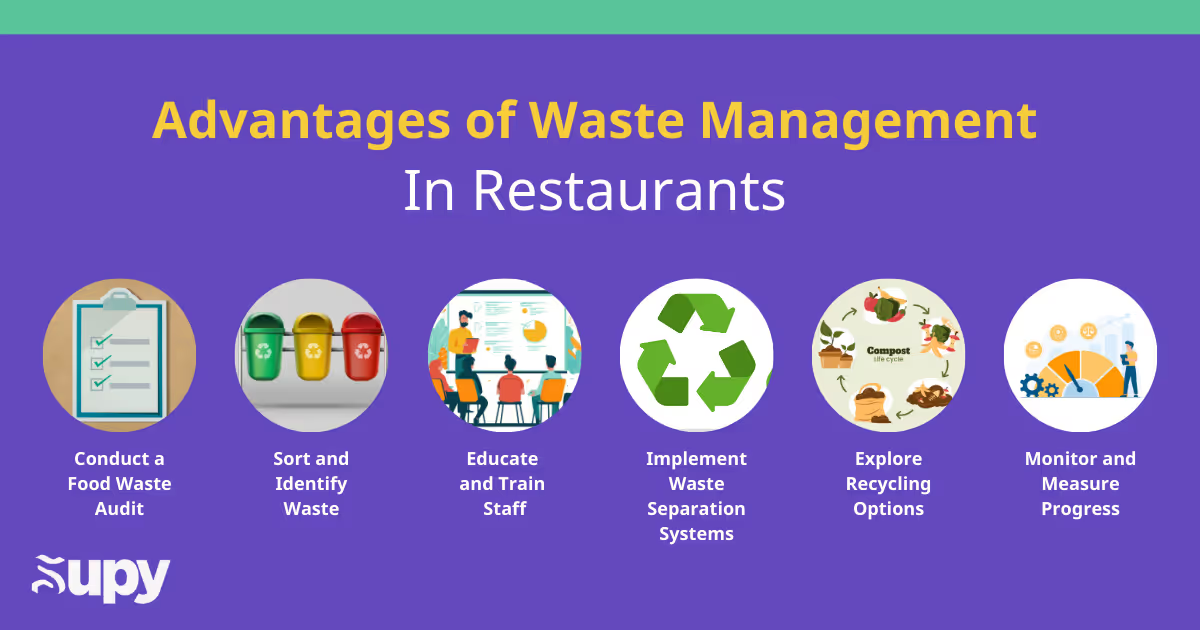
Creating a waste management plan is the first step toward implementing effective waste management practices in your restaurant. To set up your comprehensive waste management plan, follow these steps:
- Conduct a Food Waste Audit: Start by assessing the types and quantities of waste generated in your restaurant. This will help you identify any areas of improvement and determine the most suitable waste management strategies for your business.
- Sort and Identify Waste to Set Achievable Waste Reduction Goals: Based on your audit findings, set specific, measurable goals for waste reduction. For instance, you may aim to reduce your food wastage by 20% within the next six months or double your rate of recycling. This is also the stage where you
- Educate and Train Your Staff: Proper waste management requires the cooperation and involvement of all staff members. Provide training on how to store food properly, separate restaurant food waste, recycling procedures, proper waste disposal, and the importance of reducing waste. Make sure employees understand their role in waste management and are equipped with the necessary tools and resources.
- Implement Waste Separation Systems: Set up clearly labeled waste bins for different types of waste, such as food waste, recyclables, and non-recyclables. Ensure that employees and customers can easily identify and use these bins correctly.
- Explore your Recycling and Composting Options: Research your local recycling and composting facilities and identify opportunities to divert waste from landfills. Establish partnerships with recycling companies or consider on-site composting if feasible. You might even want to download the TooGoodToGo app! This certified B Corp social impact company is on a mission to inspire and empower everyone to fight food waste together. Too Good To Go's focus is on preventing good food from going to waste. By doing so, we help businesses unlock revenue from their surplus, help consumers enjoy good food at great value for money, and empower our people and partners to help protect the environment.
- Monitor and Measure Progress: Regularly track and measure waste generation, recycling rates, and progress toward waste reduction goals. This will help identify areas that need improvement and allow for adjustments to the waste management plan.

5. Case Studies of Successful Implementations.
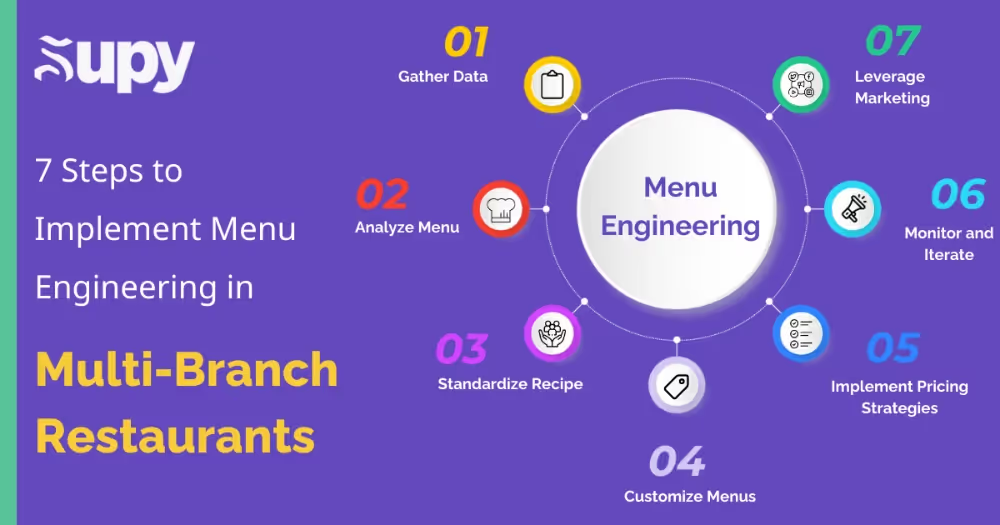
Many organizations in the food and hospitality industry have already experienced the transformative effects of centralized inventory management software. Take Burger28, for instance, a renowned local burger chain based in the UAE that keeps customers coming back for more.
Burger28 used to struggle to maintain operational excellence across its multiple locations. It was difficult to reduce variance and monitor key metrics across inventories, while also delivering insights to floor staff for data-driven decision-making. The owner, Alex Debarre, also wanted to grow his business sustainably, maximizing the productivity of employees without distracting them or having to hire more staff.
With Supy’s help, Burger28 has managed to successfully centralize its data, eliminating all paperwork from this small business and aggregating its entire inventory onto a central platform. With Supy’s centralized data management tool, you can track inventory, variance, and stock data; all updated in real time! Owner Alex Debarre is now happy to report a 6% profitability increase, and a hundred hours of manual labor saved every month!
6. Supy's Role in Establishing Effective Waste Management in Restaurants
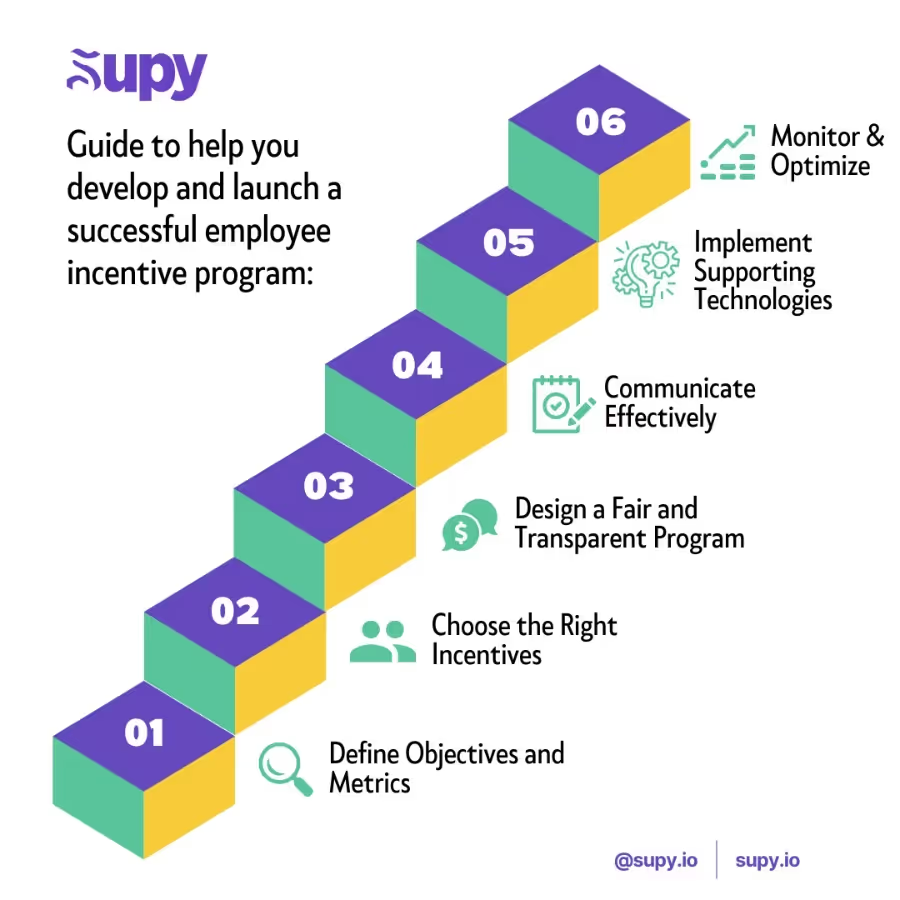
The Supy app offers comprehensive support and consulting services designed to ease the transition to sustainable waste management in restaurants. Here’s how Supy can assist:
- Centralized Data Storage: Instead of having multiple servers installed at every business location, store your data remotely on the cloud for easy inventory tracking and business processes. With that foundation, you can proactively manage waste, optimize your restaurant operations, and expand your sales channels confidently.
- Real-Time Reporting & Forecast Analytics: Forecasting tools use historical data to predict future needs, helping you to plan better and order more accurately. By analyzing past sales and consumption patterns, these tools can estimate how much of each ingredient will be required for a given period. This foresight allows you to adjust orders pre-emptively, reducing the likelihood of surplus stock that could become waste.
- Parallel Stock Counting: Accelerate stock counting and increase count accuracy by running digital, synchronized, and cross-device counting sessions with your team. Count more regularly to keep track of the variance between your actual and theoretical stock.
- Unlock Profitable Restaurant Procurement: Track purchase value per supplier, location, and category. Coordinating with your suppliers through technology can streamline your supply chain and prevent overstocking. This ensures sustainable practices like avoiding spoilage and excess inventory that can lead to waste.
7. Conclusion
In conclusion, implementing effective waste management strategies is crucial for any restaurant chain worth its salt. By focusing on waste reduction techniques such as accurate inventory management and staff training restaurant owners and managers can significantly minimize their waste generation. Regular audits and practices like composting or donating excess food not only contribute to a greener environment but also improve your restaurant’s bottom line by reducing disposal costs.
For those looking to learn more about the nuances of food waste reduction, why not sign up for our newsletter or book a consultation with Supy today? With our expertise, let us help you implement these strategies effectively and increase sustainability across your locations. Alternatively, why not check out the Xenia app for more centralized restaurant management solutions? Let’s work together to transform your waste management practices and set new benchmarks in the industry!
8. About Supy
Supy is the best restaurant management software platform tailored for multi-branch restaurants and franchises. With unbeatable features like real-time inventory tracking, smart procurement systems, and advanced analytics, Supy helps restaurants manage their various demands effectively. Whether centrally adjusting stock levels or optimizing supply chain relationships, Supy provides the tools restaurants need to thrive in a dynamic industry.
For the latest expert insights, download Supy’s ebook: The Ultimate Guide to Reducing Food Costs in Multi-Branch & Enterprise Restaurants.
Ready to find out more? Schedule a demo with Supy today and take the first step towards a streamlined, profitable future.
Related Resources




